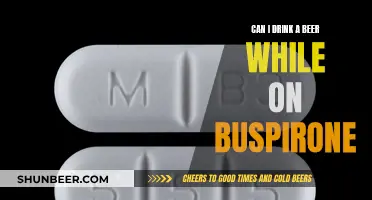
Golf and beer have long been associated with one another, with drinking on the golf course being a common occurrence in the US. However, the amount of beer consumed by golfers can vary significantly, with some choosing to abstain from alcohol altogether to optimize their performance, while others may consume several drinks throughout a round. While drinking can be a part of the golfing culture, excessive consumption can impair judgment and performance, with some professional golfers even choosing to abstain from alcohol to improve their game. Ultimately, the decision of how much beer to drink while golfing depends on individual preferences, with some golfers aiming for a balance between enjoyment and performance.
What You'll Learn

Golfers in the US drink more than their UK counterparts
Golf and beer have long been associated with each other, with some golfers believing that drinking can improve their game. However, the number of beers consumed by golfers during a round of golf can vary significantly, and cultural differences play a role in drinking habits on the golf course.
In the United States, drinking on the golf course is a common practice, with golfers partaking in various alcoholic beverages, including beer, bourbon, cocktails, and jello shots. A study by Pickswise found that golfers in Florida consumed the most alcohol, averaging 4.8 drinks per round, or a drink every 3.75 holes. Texas came in second at 4.6 drinks per round, while North Carolina, New Mexico, Pennsylvania, Nevada, and Missouri rounded out the top five.
In contrast, golfers in the United Kingdom consume significantly less alcohol during their rounds. A poll of 1,500 UK golfers found that Northern Ireland consumed the most, with an average of 0.4 drinks per round, while England and Scotland followed closely behind with a third of a pint per 18 holes. This cultural difference is notable, as even the most teetotal states in the US still outdrink their UK counterparts by over half a drink per round.
The disparity in drinking habits between US and UK golfers may be attributed to cultural norms and the perception of golf in each country. In the US, drinking during a round of golf is often seen as a social activity and an integral part of the golf experience. On the other hand, drinking on the course in the UK may be frowned upon, and golfers may prefer to consume alcohol after their round in the clubhouse.
While some golfers believe that a drink or two can enhance their performance, others opt for abstinence, prioritizing their health and fitness, and believing that alcohol does not offer any benefits to their game. Ultimately, the decision to drink or not during a round of golf is a personal choice, and golfers must find the balance that works best for them, ensuring they play to the best of their ability while also enjoying the social aspects of the sport.
Beer and Standard Drinks: Understanding the 40oz Conversion
You may want to see also

The best-performing golfers drink the least
Golfers have long debated the ideal amount of beer to drink during a round of golf. While some believe that a few beers can help loosen muscles and ease first-tee jitters, others argue that drinking too much can negatively impact performance. So, what's the verdict?
According to LPGA Tour pro Gemma Dryburgh, the key is moderation. In an interview, she suggested that one to two beers is the ideal amount for maintaining optimal performance on the golf course. She acknowledged that some people might be able to handle more, but for her, performance starts to decline after one drink. Dryburgh's perspective is supported by data from a Pickswise study, which found that golfers in the US drink an average of 4.8 drinks per round in Florida, 4.6 in Texas, and 4.2 in North Carolina, New Mexico, Pennsylvania, Nevada, and Missouri.
On the other hand, golfers in the UK drink significantly less, with Northern Ireland consuming the most at 0.4 drinks per round, followed by England and Scotland at a third of a pint per 18 holes. This cultural difference suggests that drinking habits vary widely depending on location. Additionally, an experiment conducted by Golf Digest editors provides some insight into how alcohol affects golf performance. The editors tracked the performance of three golfers with different handicaps as they hit six drives, six approach shots, and six putts, both sober and after consuming alcohol. They found that while distance remained relatively steady, driving accuracy suffered significantly after four drinks.
So, while a beer or two might help golfers relax and improve their game, overindulging can lead to a decline in performance, especially in terms of accuracy. As Dryburgh suggested, finding that "Goldilocks number" is crucial for golfers who want to enjoy a drink while still playing their best.
Beer and Flucloxacillin: Is It Safe to Mix?
You may want to see also

Alcohol affects performance
It is well-known that alcohol affects performance, and this is no different when it comes to golf. While some golfers believe that a drink or two can act as a "swing oil", loosening the muscles and easing first-tee jitters, others argue that even a small amount of alcohol can negatively impact their game. So, what is the truth? How does alcohol truly affect performance on the golf course?
The Positive Effects
It is important to acknowledge that alcohol can have positive effects on a golfer's performance, at least in the early stages of inebriation. The sense of euphoria and boost in confidence that comes with drinking can lead to improved relaxation and looser muscles. This can be beneficial when facing intimidating shots, such as those where the target is obstructed or there is limited room to land the ball. Additionally, the social aspect of drinking on the golf course cannot be overlooked. Golf is often enjoyed with friends, and sharing a drink can enhance the enjoyment and camaraderie of the game.
The Negative Effects
However, as the number of drinks increases, the negative effects of alcohol on performance become more pronounced. Once a golfer reaches the "excitement phase", their senses become dulled, and drowsiness, erratic behavior, and loss of coordination set in. This can lead to wayward shots, decreased accuracy, and a decline in overall performance. Additionally, alcohol is a calorically dense beverage, and excessive consumption can contribute to weight gain and increased health risks, including obesity and certain types of cancer. Therefore, while a small amount of alcohol may provide a temporary boost in confidence and relaxation, it is important to remember that excessive consumption will ultimately hinder performance and have negative health consequences.
Finding the Balance
So, what is the takeaway for golfers who enjoy a drink on the course? It seems that finding the right balance is key. Limiting alcohol intake to one or two drinks can provide some of the positive effects without severely impacting performance. However, as the number of drinks increases, the negative effects will become more apparent, and performance will likely suffer. Additionally, it is important to be mindful of the health risks associated with excessive alcohol consumption and to always drink responsibly.
In conclusion, alcohol can have both positive and negative effects on a golfer's performance. While a small amount may provide a boost in confidence and relaxation, excessive consumption will lead to decreased coordination, accuracy, and overall performance. Therefore, golfers who choose to drink on the course should do so in moderation to maintain their skills and avoid the negative consequences of excessive alcohol intake.
Drinking Non-Alcoholic Beer While on Probation: Is It Allowed?
You may want to see also

Drinking culture varies by region
Golf is a global game, and with it, the social aspect of the sport, including the drinking culture, varies across the world. The amount and type of alcohol consumed, as well as the social norms and expectations surrounding drinking, differ from country to country and even within different regions of the same country.
In the United States, for example, the golf culture and drinking habits can differ between the East Coast and West Coast. On the East Coast, particularly in the Northeastern region, golf is often associated with private country clubs and a more traditional, formal atmosphere. Drinking culture here might reflect this, with golfers perhaps opting for classic cocktails or spirits, and drinking in a more restrained and sophisticated manner. The West Coast, on the other hand, is known for its more relaxed and casual approach to golf, often played at public courses with stunning views of the ocean or mountains. Here, the drinking culture may be more focused on craft beers, local wines, and perhaps even cannabis-infused beverages, reflecting the region's laid-back and innovative spirit.
Moving down to the Southern states, golf in places like Georgia, Florida, and South Carolina often takes on a unique character, influenced by the region's famous hospitality and vibrant social scene. Golfers here might be more likely to enjoy a few cold beers during their round, with drinking seen as an integral part of the social experience and a way to beat the heat. The drinking culture in the South is often characterized by a strong sense of community and a focus on having a good time, with many courses and clubs offering lively post-game social events and activities.
Contrast this with the culture in Scotland, the home of golf. Here, the drinking culture surrounding the sport is deeply rooted in tradition and history. Golfers might enjoy a dram of whisky to warm up before their round, and it is not uncommon for courses to offer a 'halfway house', a traditional pit stop where golfers can enjoy a refreshment and a small snack, often including a local beer or a nip of whisky, halfway through their game. The drinking culture in Scotland is often more subdued and respectful, with a focus on quality over quantity and an appreciation for the social and cultural significance of the beverages they consume.
These regional variations in drinking culture are just a few examples of how the golf experience, and the social rituals that accompany it, can differ across the globe. Understanding these nuances can provide insight into the diverse and dynamic nature of the sport and the important role that drinking plays in shaping the social experience of golfers worldwide.
Japanese Beer Cups: The Science Behind the Froth
You may want to see also

Drinking is less common in competitive golf
Some professional golfers have even given up drinking altogether. Ernie Els, for example, stopped drinking wine and beer a month before the British Open, and other pros such as Darren Clarke and Lee Westwood have cut down on their alcohol consumption to focus on their health and fitness.
Even in the US, where drinking on the golf course is more accepted, there is a recognition that excessive drinking can negatively impact performance. LPGA Tour pro Gemma Dryburgh, who is sponsored by a brewery, suggests that one to two beers is the maximum that a golfer can have while still playing to the best of their ability.
While drinking on the golf course can be enjoyable for some, it is clear that when it comes to competitive golf, players need to prioritize their performance and well-being over alcohol consumption.
Beer Drinking: Should You or Shouldn't You?
You may want to see also
Frequently asked questions
On average, golfers drink about 4-6 beers during a round of golf. However, this varies depending on the individual and the region.
Yes, cultural differences exist in the amount of beer consumed by golfers. For example, in the United States, drinking on the golf course is more common, with Florida golfers averaging 4.8 drinks per round. In contrast, golfers in the United Kingdom typically drink less, with an average of 0.4 drinks per round in Northern Ireland and a third of a pint per 18 holes in England and Scotland.
It depends on the individual. Some professional golfers may enjoy a drink or two during a casual round, but when it comes to competitive golf, they tend to prioritize performance and maintain a high level of fitness, which may include reducing alcohol consumption.
Yes, drinking beer can impact a golfer's performance. While a small amount may help calm some golfers down, excessive consumption can lead to a decline in their ability to play at their best. It's important for golfers to find their "Goldilocks number" to balance enjoyment and performance.
Opinions vary among golfers. Some believe that 2 beers per 9 holes or a maximum of 2 beers during the entire round is sufficient, while others aim for 1 beer per hole. Ultimately, it's a matter of personal preference and how it affects the individual's performance and enjoyment of the game.







